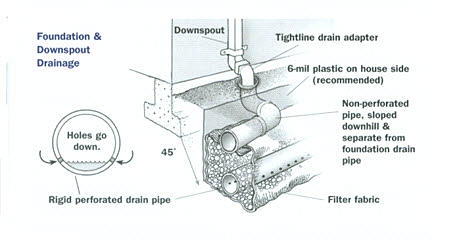Red clay based soils usually have poor drainage due to silt build up in the clay. Therefore, it is easy for yards in Georgia to hold water and these yards need proper drainage systems. Problem areas usually include run offs from your home, driveway, and other hardscapes. If not properly handled water can flood yards, patios, storage sheds, basements, and cause damage to fences. As we know turf grass likes water but too much of it can cause root rot. On the other hand, moss loves water and can almost never get enough of it. This means moss will continue to thrive as your poor grass dies. Most plants don’t do well in sitting water either. Another problem is the annoyance of having a wet or soggy yard that cannot be enjoyed up to days after a large storm or heavy rain. The long term effects of improper yard drainage can cause erosion and completely ruin ongoing/existing landscape projects. Sitting water can also slowly seep into a home’s foundation, causing problems such as mildew and cracks.
The main priority in drainage is to make sure all water is driven away from the home. Another, is to drain from higher ground to lower ground. There are many ways to divert rain water. Here are some ideas to help prevent sitting rain water in your yard:
- Roof Gutters can divert rain successfully as long as the water doesn't end up where it will create new problem areas for you or your neighbors.
- French Drains are very efficient when properly installed and connected to the sewer system. They protect a home’s foundation from water seeping in and causing damage.
- Yard Drains work well when the pipes are sloped allowing the water to flow towards the escape route. They can be connect to French drain systems.
- Wet Plants soak up a lot of water, hence the name. This is an easy and natural solution. Over time they even improve the health of soil, making it more permeable.
Another thing to keep in mind is what type of pipes there are and which is best for your yard.Perforated pipes are usually made of thick light weight plastic. Flexibility is essential because they are buried underground. When the ground expands and contracts through the seasons, more rigid pipes can crack, but perforated pipes flex with the movement and stays in one piece. The main characteristic of perforated pipes are holes or slots in the pipe so that it can fill with water when the ground becomes saturated. Corrugated pipes are manufactured from high density polyethylene (HDPE) which are noted for their flexibility and durability. They can change directions and adapt more easily to underground obstacles. Keep in mind that due to their design they tend to collect residue deposits that can easily clog the pipe and cause blockage. They will need to be cleaned at some point. There are also smooth wall sewer and drain pipe which are much more rigid than corrugated pipe and can more easily maintain a continuous slope in critical areas.
***Fun Fact: The name of the French Pipe isn't derived from the country France. It’s from Henry French, a judge and farmer in Concord, Massachusetts, who promoted the idea in an 1869 book about farm drainage.
If you have a drainage issue please contact the DR to rescue your yard! (404) 205-9335
To learn more watch our drainage videos on Youtube.
You can also check us out on LandscapeDR, HomeAdvisor, Thumbtack, Facebook, Google+ Business, and Twitter.

No comments:
Post a Comment